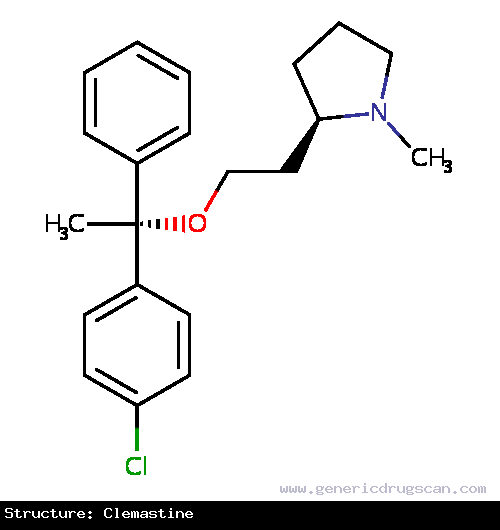Clemastine Drug: Indication, Dosage, Precaution, Side Effect , Storage, Category Type and corresponding Brands - www.genericdrugscan.com
Clemastine
Drug Status in USA : ApprovedDrug Status in Canada : Approved
pronunciation
pronounced as (klem' as teen)
Why is this medication prescribed?
Clemastine is used to relieve hay fever and allergy symptoms, including sneezing; runny nose; and red, itchy, tearing eyes. Prescription strength clemastine is also used to relieve the itching and swelling of hives. Clemastine helps control symptoms of allergies and colds but does not treat the cause of these symptoms or speed recovery. Clemastine is in a class of medications called antihistamines. It works by blocking the action of histamine, a substance in the body that causes allergic symptoms.
How should this medicine be used?
Clemastine comes as a tablet and a liquid to take by mouth. It is usually taken two or three times a day. Follow the directions on your prescription label or package label carefully, and ask your doctor or pharmacist to explain any part you do not understand. Take clemastine exactly as directed. Do not take more or less of it or take it more often than prescribed by your doctor or directed by the label.
If you are taking the liquid, do not use a household spoon to measure your dose. Use the measuring spoon or cup that came with the medication or use a spoon made especially for measuring medication.
What are the precautions to be followed?
Before taking clemastine,- tell your doctor and pharmacist if you are allergic to clemastine, other antihistamine medications, any other medications, or any of the ingredients in clemastine tablets or liquid. Ask your doctor or pharmacist or check the package label for a list of the ingredients.
- tell your doctor if you are taking monoamine oxidase (MAO) inhibitors such as isocarboxazid (Marplan), phenelzine (Nardil), selegiline (Eldepryl, Emsam, Zelapar), and tranylcypromine (Parnate). Your doctor may tell you not to take clemastine if you are taking one of these medications.
- tell your doctor and pharmacist what other prescription and nonprescription medications, vitamins, nutritional supplements, and herbal products you are taking or plan to take. Be sure to mention any of the following: other medications for colds, hay fever, or allergies; medications for depression or seizures; muscle relaxants; narcotic medications for pain; sedatives; sleeping pills; and tranquilizers. Your doctor may need to change the doses of your medications or monitor you carefully for side effects.
- tell your doctor if you have or have ever had asthma or lung disease; glaucoma (a condition in which increased pressure in the eye can lead to gradual loss of vision); ulcers; difficulty urinating (due to an enlarged prostate gland); blockage in the passage between the stomach and intestine; blockage in the bladder;heart disease; high blood pressure; seizures; or an overactive thyroid gland.
- tell your doctor if you are pregnant, plan to become pregnant, or are breast-feeding. If you become pregnant while taking clemastine, call your doctor.
- if you are having surgery, including dental surgery, tell the doctor or dentist that you are taking clemastine.
- you should know that this medication may make you drowsy. Do not drive a car or operate machinery until you know how this medication affects you.
- talk to your doctor about the safe use of alcohol while you are taking clemastine. Alcohol can make the side effects of this medication worse.
What are possible side effects of this medication ?
Clemastine may cause side effects. Tell your doctor if any of these symptoms are severe or do not go away:- drowsiness
- dry mouth, nose, and throat
- dizziness
- decreased coordination
- nausea
- chest congestion
- headache
- excitement (especially in children)
- nervousness
- difficulty urinating
- changes in vision
- fast, pounding, or irregular heartbeat
- hives
- rash
- itching
- difficulty breathing or swallowing
Clemastine may cause other side effects. Call your doctor if you experience any unusual problems while you are taking this medication.
How to store the medication and dispose it of after its use later?
Keep this medication in the container it came in, tightly closed, and out of reach of children. Store it at room temperature and away from excess heat and moisture (not in the bathroom). Throw away any medication that is outdated or no longer needed. Talk to your pharmacist about the proper disposal of your medication.
Drug Category/Class
- Anti-Allergic Agents
- Antipruritics
- Histamine H1 Antagonists
- Antihistamines for Topical Use
- Antipruritics, Incl. Antihistamines, Anesthetics, Etc.
- Dermatologicals
- Aminoalkyl Ethers
- Antihistamines for Systemic Use
- Respiratory System
- CYP2D6 Inducers
- CYP2D6 Inducers (strong)
- CYP3A4 Inhibitors
- Antihistamines for topical use
- Aminoalkyl ethers
| Prescribed | For the relief of symptoms associated with allergic rhinitis such as sneezing, rhinorrhea, pruritus and acrimation. Also for the management of mild... |
| Weight : | 343.89 |
| Structure | Clemastine |
 | |
| Formula | C21H26ClNO |
Clemastine has 4 Brands listed
| Taregyl (1.34 mg) | Taregyl (30 ml) |
| Tavegyl (1 mg) | Tavegyl (60 ml) |
Search Generic Drugs alphabetically
